 |
| Want to know how to pin baste a quilt? Check out this free tutorial. |
Continuing with some of the process of "finishing" your quilts, today I am going to share how I pin baste a small quilt. I say "small" but I am really talking about a quilt larger than 30 inches square. I consider anything smaller than 30 inches a "mini" quilt, and I baste them differently. Larger than 30 inches, we are talking about baby quilts that are likely to be USED.
Why is that important? I suppose it is not vital. But if a mini quilt is going to be hung on the wall, it is not a huge, life shattering matter if there is a small pucker on the back. No one is really going to see it unless they take the quilt off the wall. But, if a quilt is going to be used, there is a good chance that someone is going to see the back as often as the front and I don't want any puckers in the quilting.
Where am I going with this? I spray baste my mini quilts. Spray basting is not as secure as pin basting. Things can still shift a bit and cause puckers. On a mini quilt, the surface area is much smaller so the puckers are small; whereas across a bigger quilt and more surface area, your puckers can be pushed and pushed across the quilt and end up HUGE. Pin basting is a bit more secure for baby quilts and larger - not to mention much easier to do by yourself!! Let's get started.
I pin baste on my kitchen table. This table is great for many reasons:
- It is already all scratched up thanks to the kids
- It has a leaf in it which allows me to expand the table from about 36 inches wide to 54 inches wide for bigger quilts.
- It is less than 1 inch thick all the way around, so I can use binder clips easily
- Without the leaf in, I have this nice seam right in the middle of the table.
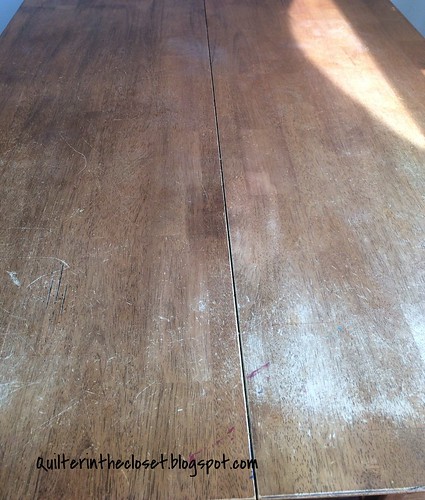
Just keep in mind that whatever you use, the pins will leave tiny scratches. So I don't recommend basting on any surface that you don't want scratched up. Also, don't baste on carpet. You will just end up pinning your quilt to the carpet. So pick a hard surface that you don't mind scratching up - a clean garage floor would be my personal 2nd choice for example.
Step One: Prepare your layers
Before I begin, I press both my backing and quilt top. My backing is usually at least 3 inches larger, on all sides, than my quilt top, and my batting is about the same size as my backing. Personally, I haven't found these "extra" inches that important in the shifting of the layers while quilting as it is in the difficulty of lining all the layers up in the basting process. No matter how perfectly centered I think my backing and batting layers are, they end up getting smoothed out of alignment a bit and those extra inches come in handy.
Step Two: Place your backing on the table
Place your backing, right side DOWN on the table.
For small quilts, I find it pretty easy to guess where the middle of the backing is, but if you want a process that is a little more accurate, see the way I lay out the top below and do the same for the backing, making sure that it is right side down.
Make sure your "helper cat" is in place.
And clip your backing into place. Please notice 2 things in the picture above. First, my table is 54 inches long and is too long for the length of this quilt. SO, I have used plain old masking tape to tape those edges to the table. If you are working on the floor, this is what you will do instead of clipping (you can't clip to the floor, can you?). Also notice that many of those tiny fold marks (that for some reason didn't press out) that are in the pictures above have been SLIGHTLY stretched out. I don't advocate pulling your backing so tight that all those fold marks are completely gone. If you run your fingers along the backing, it should still move slightly. Otherwise, when you release your pinned quilt, the backing is going to be tighter than your batting and top and will seize up creating puckers on the FRONT of your quilt.
Ideally we are going for all your layers to be the same "tension" -- smooth, but not tight.
Step Three: Put your batting on the table.
Did you know batting has a right side and a "wrong side"? It does. Well, at least cotton batting does.
If you look closely at your batting, and I mean closely. You will notice a bunch of little holes. Those come from the process of making the batting - they actually punch it with a bunch of needles to make the cotton play nice. They punch those needles from one direction. The "right side" of the batting is where those needles entered the batting.
The "wrong side" is where the needle punched through. So while your wrong side will have some holes in it, it also has some little nubs where the cotton was pushed out of the way by the needles.
Since you will essentially be punching your needle through the batting during the quilting process, you want the right side of the batting to be up when basting. So put your batting on the table, right side UP, and clip it to the table using the same clips you used for your backing. I like to squeeze the area right next to the clip, holding the layers in place while I re-clip.
I usually DON'T tape down my batting. Keeping my backing in place with tape is important. The batting will stick to the backing enough to keep it reasonable in place on those edges. If my quilt had been large enough to cover the table completely, yes, I would have re-clipped on all sides.
Step Four: Time for the Quilt Top
Fold your quilt top in half, wrong sides out, and then in half again (wrong sides out). Now place your folded quilt in a quarter of the table (easier to show in a pic than say in words).
I've lined up my folds to be on the center lines of the table.
As I unfold my quilt top, it will be centered on my table.
Once it is all unfolded. I smooth it out from the center out and clip it to the table.
Step Five: Get out your pins!
I use Dritz Quilting Curved Basting Pins ( this is an Amazon link (use a coupon at Joanns and get them even cheaper))
The curved pins are a bit easier to use in the basting process. Plus, buying pins specific to quilting usually means they are plated differently than regular safety pins, which means they shouldn't rust.
Start along the center lines of your quilt and pin all your layers together by sticking a pin in from the top, hitting the surface below (the table) and then pushing the pin back to the top layer.
I like to pin one quarter of the quilt at a time, but that has more to do with how my table is set up. I just have to move from one chair to another to get to the next quarter of the quilt.
Pin at least every 3 to 4 inches. I've heard many people say that if you put your hand down on the quilt, it should be touching at least one or two pins. But you should also place your pins where they make sense.
I think about the blocks themselves and let their designs dictate where I place my pins rather than just a standard every 3 inches in rows.
Also remember, what are you going to do after your quilt is basted? Quilt it, right? So, when possible, I also like to pin far enough away from the seams that I don't have to move the pins when I stitch in the ditch.
There really isn't any such thing as too many pins. As you can see in the picture above, my pins are much closer than 3 inches apart in some areas. Yes, it took longer than if I just placed pins in rows, but I also didn't have any shifting when I quilted it.
Soon, the entire surface showing on the table will be pinned.
Um, Jen? What if my quilt is bigger than the table? Well, you do need to pin those areas too.
Un-clip your quilt completely, slide your quilt in one direction** to get a long (border in this case) section of the quilt onto the table, clip the opposite side first, then reach under your quilt and grab your backing, pull it slightly (again not to tight) and clip it to the table, smooth out your batting and clip it to the table, then smooth out your quilt top and clip it to the table. You are essentially building the tension in the same way you did the original setting of the quilt, that way all your layers are the same. (I don't bother re-taping for such a small area.)
You only want to slide the quilt so that the edge of the quilt is on the edge of the table. That way it is still able to be clipped into place. Cindy Needham also recommends that you leave at least 6 inches of pinned quilt on the table to avoid puckers. For this small quilt, I only had a few inches that didn't get basted during the first set up; but for larger quilts, you might have an entire table worth of un-pinned quilt. In that case, you would need to leave 6 inches of pinned quilt on one side of the table, clip it in place, pin the exposed quilt, un-clip it, shift the quilt again and repeat the process to finish up any un-pinned area. I hope to address this in another tutorial. I just have to get my big Swoon quilt ready.
**Why only one direction (or side of the quilt) at a time? For example, readjusting to get a whole corner of the quilt. This is another tip I picked up from Cindy Needham. If you shift your quilt to expose more than one side a time, you are adjusting the tension of your backing and batting layer in a different way than your original set up. Thus, you are more likely to get weird puckers in those areas. I didn't want to believe Cindy, but through trial and error, I have found this to be true. If I don't get a strange pucker, then I get a stretched out corner.
Step Six: Check the back.
When you have your entire quilt top pinned. Un-clip your quilt, flip it over and look at the back. Check to make sure you don't have any puckers, and that your pins went all the way through the layers.
One final tip for beginners. You might consider pinning a little off the quilt.
Why? When you are quilting right up to the edge of the quilt, and rotating it, etc. It is really easy for those "extra" inches of backing and/or batting to roll under the edge of your quilt and get quilted. It usually isn't any more than an inch or two, but man is it a pain in the butt to discover after you are all done, that you have to pick out the stitching in those areas. Pinning off your quilt an inch or two (and you don't need to keep the "every 3 inches" guideline) keeps those areas clear. It only takes a few extra seconds, and is well worth it.
And don't forget to have your "helper" hold down the quilt when you are basting it.
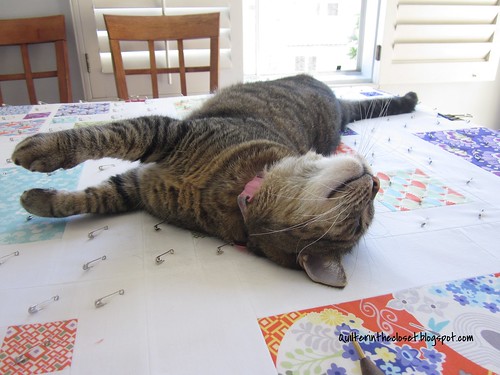 |
| Using a cat to weigh down your quilt as you baste it, is always recommended. |
How do you do baste your small quilts? Link up your tutorials here (on this or any other quilting subject).
Rules:
1) NO QUILT POLICE ALLOWED! - if you are making a tutorial, keep it friendly, as if you were teaching your best friend. If you are visiting a tutorial, please remember that the authors are simply sharing what they have found to work for them.
2) Please link up tutorials from 2014 only. Feel free to point out any previous tutorial in your new post, but let's try to keep the links current.
3) Visit other linky participants to see how they do it.
4) Did I mention no quilt police allowed?
Thanks for joining me today!
Jen

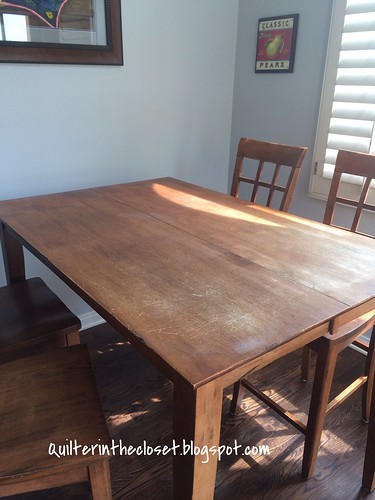
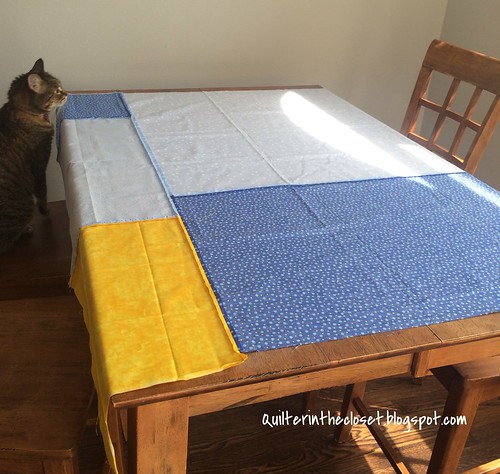
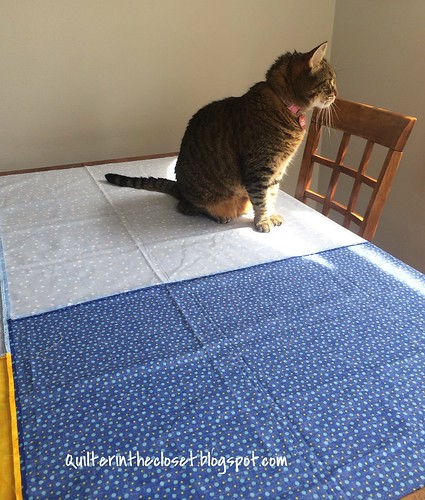
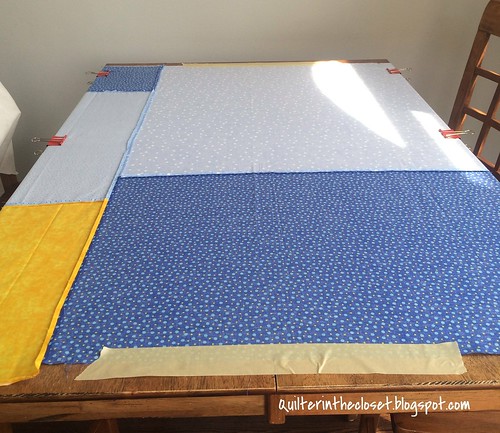

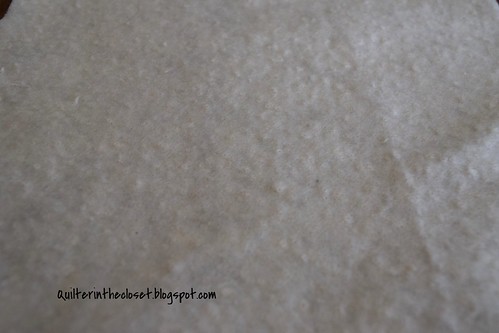
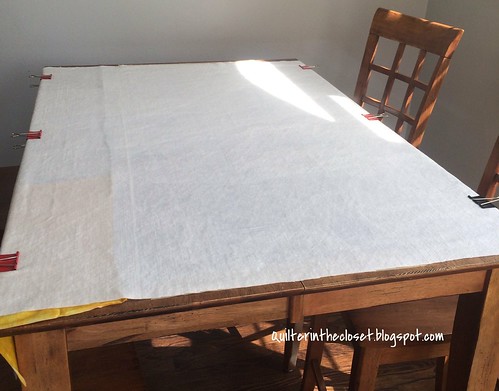
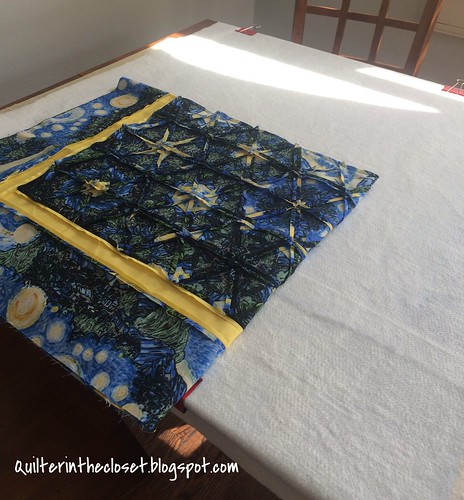
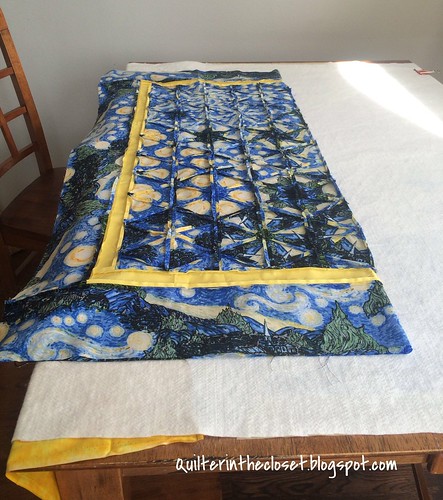
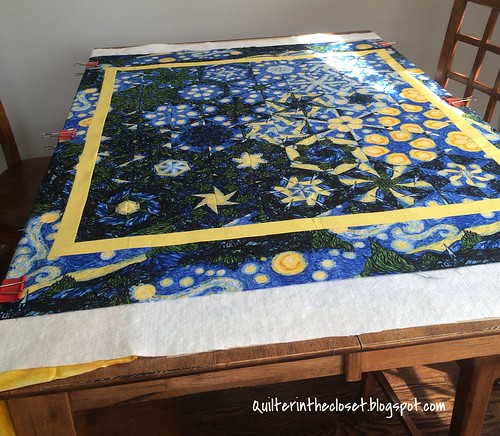
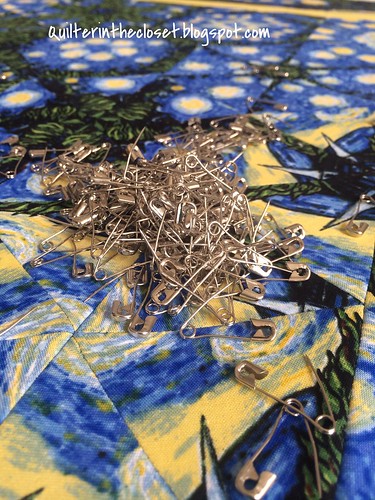
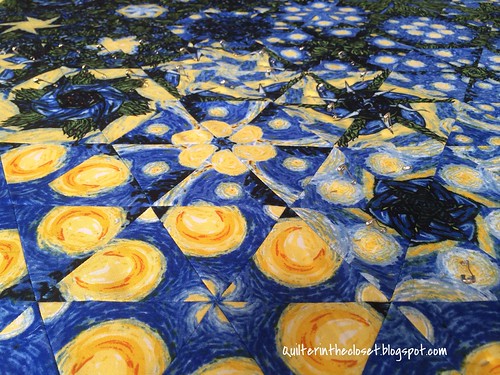

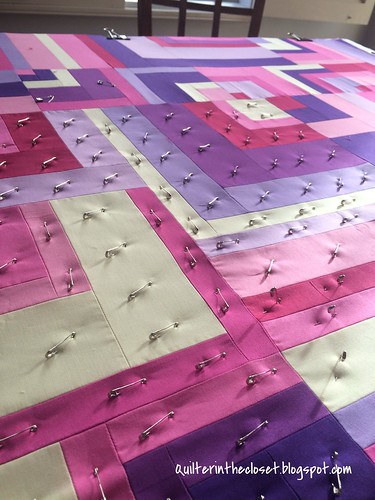
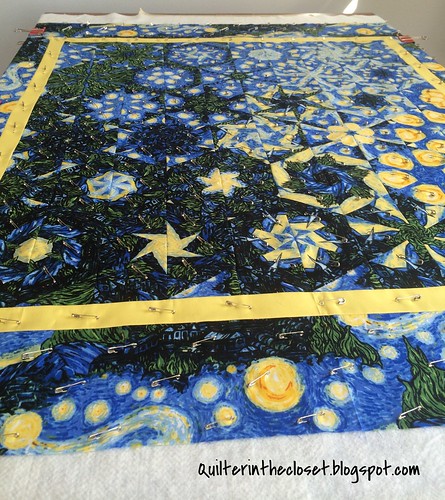
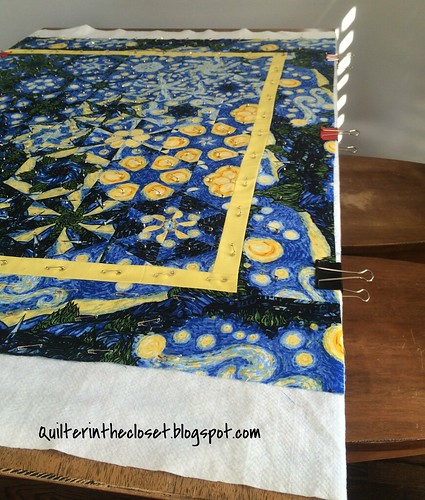
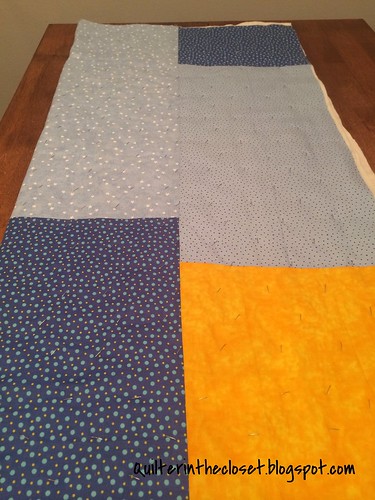
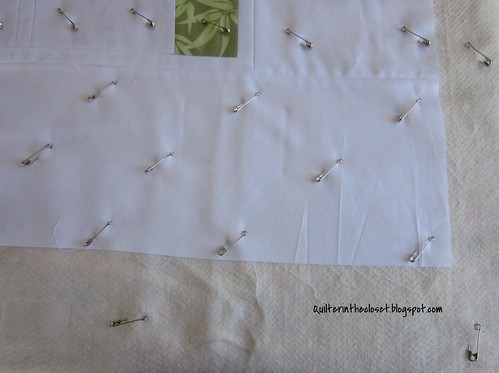

Fantastic post. I have had my first quilts long arm quilted but I plan to machine quilt my next myself. I have bookmarked this to help. Thank you so much!
ReplyDeleteGreat tips! I must get one of those cat helpers :-)
ReplyDeleteLooks great, I wasn't looking forward to crawling on the floor.
ReplyDelete24Tangent "at" gmail "dot" com
Thanks so much for this. And, great news--I have several lookalike cats here to help me get it right.
ReplyDeleteWell done! I had never put any thought into which way batting goes, but this really makes sense:-)
ReplyDeleteBrilliant, as always! I knew about the holes showing the right side on fabric ( useful of solids) but never though to apply that to wadding / batting, thanks x
ReplyDelete